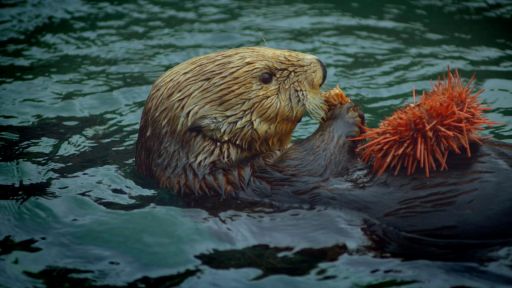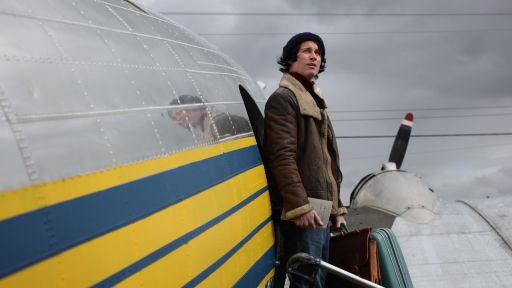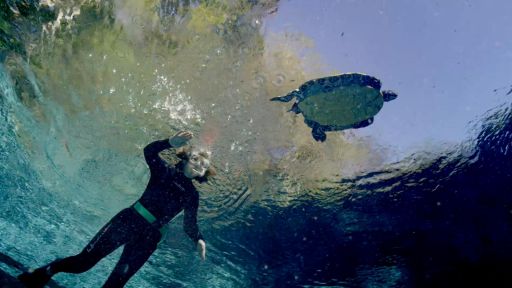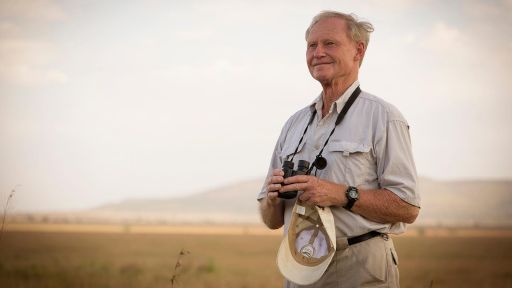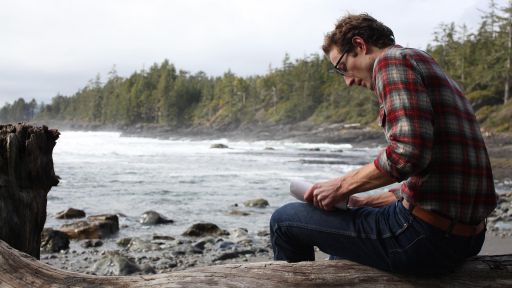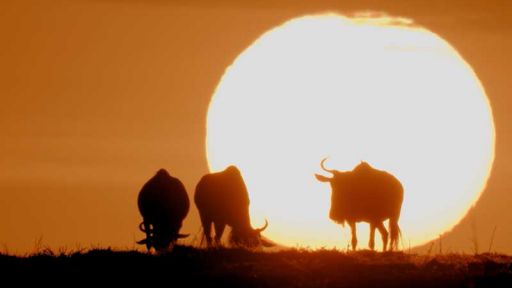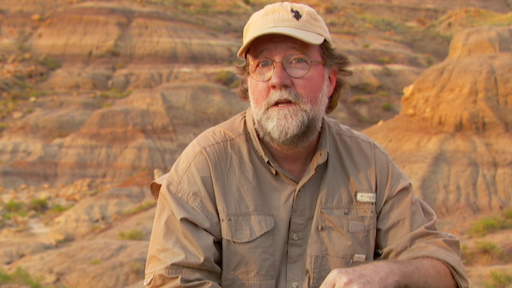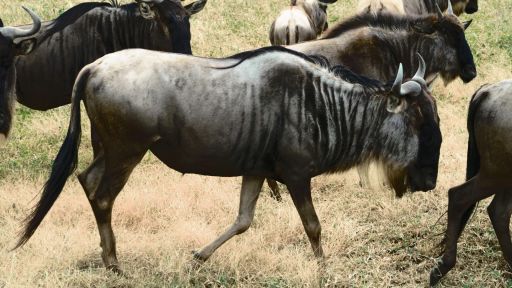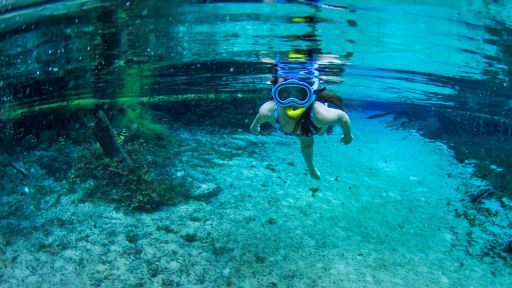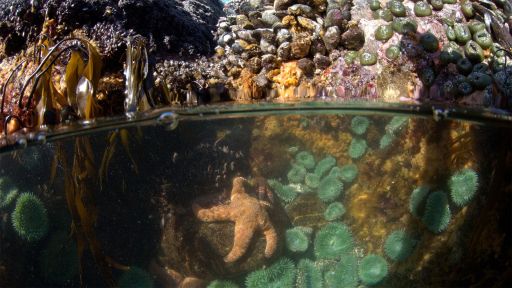TRANSCRIPT
♪♪ ESTES: The most dramatic moment of learning in my life happened in less than a second.
I stuck my head in the water, and I thought, "This is unbelievable."
NARRATOR: 50 years ago, a group of scientists set off around the world to unlock the mysteries of nature.
TERBORGH: I had never seen anything like this before.
Whether it was terrestrial or aquatic, whether it was arctic or tropical, it was all working in the same way.
SINCLAIR: We found the rules -- how systems work, how the world works.
ESTES: This was a major deal.
NARRATOR: Their collective knowledge proved that some animals are more important than others.
ESTES: If you lose the wrong ones, if you lose the keystones, you're going to see very big changes.
NARRATOR: These findings were revolutionary, a new insight into nature.
Join these unsung heroes as they tell their unique story of hope... ♪♪ ...of how we can preserve life on our planet.
♪♪ ♪♪ ESTES: There's a sign when you get off the airplane there -- "Not the end of the world, but you can see it from here."
NARRATOR: They ventured into the wild, from the coasts of Alaska to South American jungles.
TERBORGH: I was stunned.
I had never seen anything like this before.
[ Animals squawking, grunting ] NARRATOR: In North American Rivers, And on African plains, they followed their passion to explore.
SINCLAIR: I'd longed to be in such a place ever since I was a small boy.
NARRATOR: Their quest pursued over a lifetime was to understand how nature is put together.
POWER: I'd try to go out looking to see how the world works.
SINCLAIR: I've always said that science is detective work.
There's a mystery to solve.
TERBORGH: Science can tell us what's happening when the naked eye can deceive us.
NARRATOR: And now, after 50 years of research, their discoveries fit together.
TERBORGH: Whether it was terrestrial or aquatic, whether it was arctic or tropical, it was all working in the same way.
ESTES: This was a major deal.
NARRATOR: It is a blueprint to help heal a battered planet.
♪♪ POWER: It was a flashbulb moment.
Nature could heal itself.
ESTES: I've never in my life felt such an excitement.
[ Zebra whinnies ] SINCLAIR: We found the rules -- how systems work, how the world works.
NARRATOR: This is a story of hope that will change the way you see nature.
[ Radio tuning ] It begins in the Pacific Northwest.
[ Radio tuning ] Bob Paine is a newly-minted biology professor at the University of Washington.
PAINE: It was exciting.
I was totally naive.
Basically hadn't seen any of the Pacific coast ecosystems.
NARRATOR: As a naturalist, he's trained to observe and record, but Bob is thinking more radically.
He wants to see how things work by manipulating nature.
♪♪ When Bob was in school, the general idea was that all natural communities are arranged the same way.
The sun's energy drives the structure of life.
Plants grow using sunshine.
Grazers eat the plants, and they in turn are hunted by predators.
[ Wolf howls ] Everywhere on earth, nature is organized from the bottom up.
♪♪ ♪♪ Yet Bob Paine is most fascinated by the predators at the top.
♪♪ [ Eagle chirping ] Could they play a more important role than simply eating a little meat at the summit of a food pyramid?
♪♪ [ Raven croaking ] But how do you test that?
You can't just get rid of all the bears or eagles from a forest to see what happens.
Bob Paine needs a natural community he can easily manipulate.
♪♪ ♪♪ At the tip of Washington's Olympic Peninsula, he stumbles upon a small but magical world.
Few biologists had paid much attention to the tide pools along this rocky shore.
But for Bob, they present the opportunity he's been dreaming of.
PAINE: There it was spread out in front of me.
♪♪ It was Nirvana.
♪♪ NARRATOR: He realizes these tide pools are a complete ecosystem, but in miniature.
PAINE: This magnificent array of organisms.
There were carnivorous gastropods feeding on barnacles.
There were sea urchins feeding on algae.
There was a lot of pattern.
NARRATOR: For Bob, the tide pool is a natural laboratory.
There are hunters and filter feeders, scavengers, and plants giving food and shelter.
♪♪ And among the mussels and barnacles, anemones and snails, a large predator lurks.
♪♪ Despite appearances, starfish are skilled hunters.
♪♪ Each of their arms carry eye-like sensors.
♪♪ Starfish use their tube feet to pursue prey.
They can pry open mussels, devouring them in their shells.
♪♪ ♪♪ Here, Paine conducts one of the simplest experiments in the history of biology.
♪♪ He removes starfish from one tide pool, while leaving them in another.
♪♪ ♪♪ Month after month, Paine returns, clearing out starfish.
♪♪ And he sees the tide pool changing.
♪♪ There are more mussels, but less of everything else.
♪♪ Eight years later, the impact is dramatic.
♪♪ The mussels are all that remain.
♪♪ That indicates that the starfish have been preventing the mussels from taking over.
♪♪ The predator maintains the entire community from the top down.
Without them, it all falls apart.
♪♪ ♪♪ In other experiments, Paine removes different species from the tide pools.
But when he does that, nothing changes.
The starfish alone hold everything together.
So Bob christens them a "keystone species."
PAINE: I knew that I had discovered something important.
I'd changed the nature of the system.
I used the line in George Orwell's "Animal Farm."
"All animals are equal, but some animals are more equal than others."
And that expresses the fact that all species don't have the same impact on the system they're in.
♪♪ NARRATOR: Bob's discovery of a keystone species prompts more questions.
Do they only exist in tide pools?
What's the scale of their influence?
♪♪ New revelations will soon link starfish to sea otters living thousands of miles farther north, in the remote Aleutian Island chain off Alaska.
♪♪ The connection will be made by a young man who has yet to hear of Bob Paine's work and isn't even sure he wants to be a marine biologist.
ESTES: Everybody has to do something.
I was actually thinking about doing a lot of things other than biology.
I was thinking first and foremost about surviving, you know, making a living, being able to make my way in the world.
♪♪ One of my former professors at Washington State was a consultant with the Atomic Energy Commission.
And they were looking for somebody to go out to Amchitka Island and work on sea otters.
I had never worked in the ocean.
I was not a marine biologist.
I knew nothing about the ocean.
♪♪ And he said, "You know, I think you'd be perfect for this."
♪♪ Two weeks later, I was on my way to Amchitka Island.
There's a sign when you get off the airplane there -- "Not the end of the world, but you can see it from here."
♪♪ I had this feeling of both excitement for the beginnings of a new life and also an incredible sense of trepidation over whether I would succeed or not.
♪♪ NARRATOR: In the seas off Amchitka Island, Estes gets to know the sea otters.
Highly social, they spend their entire lives in the icy water.
♪♪ Without blubber for insulation, they have evolved the densest fur of any mammal.
♪♪ ♪♪ Sea otters are masters of their underwater realm, the kelp forest.
♪♪ ESTES: It is spectacular.
♪♪ It is absolutely one of the most amazing scenes that I've ever seen.
Kelp to the coastal ecosystem is like redwoods to a redwood forest or oaks to an oak forest.
The kelp forest is an important foundation for the coastal ecosystem.
♪♪ NARRATOR: Like any forest, kelp is a rich source of food, home to dozens of species.
♪♪ Estes is interested in how kelp can support everything from spiky urchins... ♪♪ to the large sea otters that eat them... ...how everything is organized from the bottom up.
[ Thunder crashing ] But his world view changes the day he encounters Bob Paine, who is visiting Alaska to meet with a student.
ESTES: The instant I met him, I thought, "There's no way I'm going to talk to this guy."
He just scared me to death.
He was very smart, very intimidating.
[ Indistinct conversations ] And he said, "You want to sit down and talk a little bit about what you're doing?"
i told him that I was interested in following this notion of how kelp forests could support so many otters."
He said, "It sounds pretty dull to me."
♪♪ "Why don't you think about these animals as predators?"
It just immediately occurred to me that this was a phenomenally interesting natural experiment.
And that was sort of the beginning of the rest of my life.
♪♪ NARRATOR: Paine's question turns Estes' research on its head.
Instead of asking what the kelp forest does for the otters, Jim now asks what are the otters doing for the kelp forest?
ESTES: When Bob planted the seed of looking at the effect of otters, it naturally occurred to me that the way to do that would be to go to someplace where they didn't occur and compare that with where they did.
♪♪ If the otters are having some big effect, I ought to see it.
If I go to a place where they don't occur, I ought to see it.
♪♪ NARRATOR: Having nearly been wiped out by the fur trade, sea otter populations are recovering and spreading out across the Aleutian Island chain.
But the otters have not yet reached the shores of the most remote islands.
One is called Shemya.
♪♪ ESTES: The most dramatic moment of learning in my life happened in less than a second.
♪♪ I stuck my head in the water at Shemya, and I thought, "Oh, my God.
This is unbelievable."
♪♪ I'd never seen an urchin barren before going to Shemya.
♪♪ From having watched otters for extensive periods of time, I knew they ate a lot of urchins, but it never really occurred to me until I actually saw a system where otters were gone that the effect was massive.
♪♪ NARRATOR: Unchecked by the otters, the sea urchins have gorged on the kelp.
That has started a devastating domino effect right through the community.
The kelp forest and virtually everything that lived here is gone.
Jim has discovered that sea otters, like starfish, are keystone species.
♪♪ ESTES: I sat there all night long.
I didn't sleep at all that night.
All I did was write.
I think I had some sort of visceral sense that this was a major deal.
♪♪ I've never in my life felt such enthusiasm and excitement as I felt at that moment.
NARRATOR: Jim Estes takes Bob Paine's keystone discovery to a new level.
Both large and small marine habitats seem to be held together by single keystones, whose removal is catastrophic.
♪♪ The potential power of keystones begins to attract the attention of other biologists, who ask new questions about how keystones work.
[ Eagle chirping ] Freshwater ecologist Mary Power now wonders if the influence of keystones goes beyond predators simply eating prey.
♪♪ An underwater hunter would help Mary see something neither Jim nor Bob had.
♪♪ Ironic perhaps, because growing up, Mary couldn't see well at all.
♪♪ POWER: When I was a child, I was severely myopic from who knows what age.
♪♪ I didn't know that you could see leaves on a tree from the ground.
♪♪ But something happened before I got glasses, and that was that I was let loose with a mask and snorkel.
♪♪ For the first time, I saw things clearly because of the refraction of the water.
♪♪ You can imagine how beautiful it would be when you see detail that you'd never known you could see.
♪♪ What were pondweeds above the water were forests of stems under the water.
And in this little forest, there would be sun fish.
♪♪ Then occasionally, a big, larger predator like a pickerel or a perch or a bass goes by.
♪♪ ♪♪ ♪♪ It was a flashbulb moment, as they say, where I just had to be underwater looking at life that way, for the rest of my life.
♪♪ ♪♪ ♪♪ NARRATOR: Following her passion, Mary Power focuses her studies on fish in the rivers and streams of Oklahoma.
♪♪ Her keen eye soon notices a striking difference between some stretches of river and others.
♪♪ Some pools are like mini green forests, teeming with life.
♪♪ Here, largemouth bass are the top predator.
♪♪ But other pools are barren.
Bass are nowhere to be seen.
♪♪ Here, small minnows eat everything right down to the bare rock.
♪♪ Power suspects bass might be a keystone holding the community together in the lush, green pools.
To test her hunch, she designs her own version of Bob Paine's starfish experiment.
♪♪ POWER: We split the green pool into two halves.
♪♪ We netted out the bass, and then we added minnows just to one side.
♪♪ And we sat back and waited.
♪♪ ♪♪ NARRATOR: In just five weeks, on the side without bass, the minnows have reduced the green pool to rubble.
♪♪ With the top predator gone, the minnows overgraze the plants.
♪♪ But there is something more in the green pools.
The bass are not just eating the minnows.
♪♪ Mary realizes the predators instill a "fear factor."
♪♪ POWER: About half the effect of bass is due to terrifying the minnows so they not only stop feeding, but they emigrate.
And that's a landscape of fear.
Bass are keystone species just in the sense that Jim's sea otters or Bob's starfish are.
♪♪ NARRATOR: But there is still a major piece of the puzzle missing.
♪♪ No one has shown that keystones exist on land.
♪♪ That search will turn up something unexpected and sound an urgent alarm.
♪♪ The scientist that will ring it spent a lifetime in the forests, beginning when he was a boy.
TERBORGH: I loved being in the forest.
♪♪ Not see people, just be in the forest.
[ Birds chirping ] Some of my fondest memories of that period were of catching fireflies in the evening.
Every summer, they would emerge about sundown and then come up one by one.
There were birds that would sing on into the night and frogs, and I've always loved listening to the evening and night sounds in Virginia there.
[ Animals chirping ] ♪♪ NARRATOR: John Terborgh will go on to become a forest ecologist, working primarily in the tropical jungles of South America.
It is from here that he will mull over the concept of keystone species.
TERBORGH: Mary Power's work in streams, Paine's work in the intertidal, and Jim's work in the ocean -- They did seem to work in a wide range of aquatic environments.
So at that time, I started daydreaming, how could I expand on this?
[ Birds singing ] NARRATOR: Forests cover a third of our planet.
If John can show keystones holding together communities here, it will suggest that their power is global.
♪♪ Yet to succeed, John still has to overcome the same basic challenge Bob Paine had faced 25 years before... ♪♪ ...how to remove the predators.
♪♪ TERBORGH: What I needed was to do an experiment, but on land instead of in the water.
That meant finding fragments of forests without any predators but with everything else still there.
I didn't know of any such place until I learned about Guri, and that's where it all began.
♪♪ NARRATOR: Guri was an area of tropical jungle half the size of Connecticut, flooded by the construction of a new hydro-electric dam.
♪♪ Now wooded hilltops are small islands.
♪♪ With little food to eat, predators like jaguars face starvation and abandon the islands.
♪♪ TERBORGH: Everything that should've been there was there except for the top predators.
It was the perfect system so that you could see what the response to removing predators would be.
NARRATOR: The impact shocks Terborgh.
♪♪ TERBORGH: When I climbed up and walked into the forest, it looked like a hurricane had been through there.
Wow.
NARRATOR: With fewer and fewer predators, plant eaters ravenously devour the trees.
Whether it's howler monkeys or iguanas makes no difference.
Even size doesn't matter.
On islands without predatory army ants, hoards of leafcutters wreak havoc.
♪♪ TERBORGH: On the mainland, leafcutter ants are controlled by a species of army ant.
Without them, the leafcutters are 100 times more abundant than they would be on the mainland.
The foliage had been stripped off the trees so many times by this multiplicity of leafcutter ants.
♪♪ A tree can only withstand that so many times, and then it dies.
♪♪ It's all predation-driven.
You remove predators, then it leads to the deterioration of the whole system.
♪♪ NARRATOR: To Terborgh, it's a chilling realization, because we've been systematically targeting predators for centuries all across the world.
Our planet has been rapidly changing.
♪♪ We've transformed it.
As we take out the top predators in our path, nature is being decapitated, the ties that bind entire communities broken.
TERBORGH: What humans have done is take nature apart layer after later.
From loss of top predators, there's almost always loss of diversity.
♪♪ After we understood that, we coined the word "downgrading" to describe it.
♪♪ NARRATOR: John Terborgh's trained eye now sees downgrading all around us.
TERBORGH: I can see it.
I'm not sure just anybody can see it.
Science can tell us what's happening when the naked eye can deceive us.
Remember we found at Guri that with no predators, the herbivores increased, and the ants literally ate down the forest.
We're seeing the same thing here.
It's not ants, it's deer, but out of control, they can lead to the same rather disastrous consequences.
The deer have reached plague abundance.
And it's the deer that create this effect as if you had taken a hedge clipper and gone along on the underside of the branches, removing everything between the ground and what we call a browse line.
NARRATOR: The deer plague started as we removed wolves to make room for people.
Now the forests Terborgh knew as a boy are collapsing.
TERBORGH: If this forest were whole and natural and reproducing normally, you wouldn't see me from the camera.
There would be things in between.
But you can look way out there, and there's no obstruction.
The visibility is 100 feet or 200 feet.
It should be maybe 10 feet or 15 feet.
That's the difference.
There's nothing in the middle.
♪♪ It's a disappearing forest.
♪♪ These big, old trees, they're the last of their generation.
When those oak trees die off, there wouldn't be a forest there anymore.
♪♪ I remember a better world, and now I see things going in a direction that disturbs me enormously.
Every day of the week, I can't stop thinking about it.
♪♪ ♪♪ NARRATOR: Downgrading is a disturbing reality, but is it earth's destiny?
♪♪ The fate of the natural world is the last thing on the mind of a young biologist when he first arrives in what appears to be a pristine natural wilderness.
SINCLAIR: In 1965, the Serengeti was not well-known.
There were hardly any tourists.
♪♪ People weren't aware of the remarkable nature of that ecosystem as they are now.
♪♪ [ Ostrich chirps ] ♪♪ [ Wildebeest grunting ] ♪♪ There was everything around me -- all of these species all mixed up together.
It was just too good to be true.
I'd longed to be in such a place ever since I was a small boy.
♪♪ ♪♪ NARRATOR: Little doe Tony realize, at that time, the Serengeti is the midst of a dramatic change.
Tony joins animal counts that reveal wildebeest and buffalo numbers are rising rapidly.
♪♪ SINCLAIR: When I first started, the wildebeest were somewhere around 250,000 animals.
♪♪ By the time I'd finished three years, there were 400,000 of them, and everybody thought, well, they must have reached their limit.
And the next time we looked, it was 700,000.
♪♪ Four years later, they had doubled again to 1.4 million.
We had a world record.
For a large mammal, they just don't do that sort of thing.
NARRATOR: Tony determines the growing numbers are the result of a rebound.
It turns out the wildebeest had been decimated by a virus spread from cattle.
But once the virus was eradicated in livestock, the wildebeest started to boom.
♪♪ But was this a blessing or curse?
SYNC: Our next speaker is a Mr. Tony Sinclair from Tanzania.
NARRATOR: When Tony goes public with his record-breaking results, he thinks this is a good news story.
SINCLAIR: To 1.4 million.
NARRATOR: But park managers fear these increases can't be sustained.
Too many wildebeest will overgraze.
SINCLAIR: There was a deathly hush.
I wasn't expecting that reaction at all.
Everybody thought we were being irresponsible.
We should have been culling these animals because they'll overgraze the place, destroy the habitats, and they were going to cause a collapse of the system.
MAN: I just want to point -- MAN #2: It's already been proven!
[ Indistinct arguing ] NARRATOR: But Tony believes the cattle disease had artificially kept the wildebeest numbers low.
♪♪ What he's observing is a natural reset.
SINCLAIR: The way I looked on it was that animal populations have been in existence for millions of years without having to have humans control them.
We decided we were going to stick to our guns, and we prevailed upon the park authorities not to give in to culling, but to wait and see what was going on.
If we were wrong, we could be destroying one of the iconic places on earth.
♪♪ NARRATOR: For the next three years, Tony keeps a close watch on the wildebeest, looking for signs they're overgrazing the grasslands.
♪♪ But after two more counts, numbers remain steady at 1.4 million.
♪♪ SINCLAIR: At that point, we knew that the system had leveled out of its own accord, and there was no damage to the environment.
♪♪ NARRATOR: The wildebeest find their natural balance.
But what happens next amazes even Tony.
♪♪ He and his colleagues witness an incredible transformation.
♪♪ SINCLAIR: To our surprise, we found that all of a sudden, things started to reconnect with each other.
Because the wildebeest were eating up the grass, there was less fuel, and, therefore, less burning.
That allows young trees to grow.
Wildebeest, of course, do not eat trees, and that allowed the tree populations to increase.
♪♪ Tree populations that probably hadn't occurred since the 1800s.
♪♪ Those trees provided more food for elephants, for giraffes, and for many, many bird species.
♪♪ And then there are many more predators because there's more food for those, too.
♪♪ The wildebeest in their huge numbers were determining everything else inside the park.
[ Wildebeest grunting ] I realized that wildebeest was a keystone.
[ Wildebeest whinnying ] ♪♪ We had always assumed that keystones had to be a predator, but we realized that a keystone could actually be herbivores.
♪♪ NARRATOR: And if removing keystones causes collapse, returning them leads to rebirth.
We were seeing a recovery, an upgrading of the whole ecosystem for the first time.
[ Wildebeest grunting ] TERBORGH: Tony's work is marvelous.
I was delighted because here is recovery, here is upgrading.
But it's a long, long process.
We're almost 60 years down from Bob Paine's work with the starfish.
I think we're finally arriving at a much better place, but it has taken that long.
♪♪ NARRATOR: They started out strangers, each a witness to the power of keystones.
By 2008, the small bands of scientists has grown its ranks.
♪♪ What was once maverick thinking is becoming mainstream science with the discovery of more keystones from around the world.
SINCLAIR: It was only by listening to each other that we realized we were talking about the same thing.
TERBORGH: Whether it was terrestrial or aquatic, whether it was arctic or tropical, it was all working in the same way.
ESTES: There wasn't anyone that argued, "I don't see this in nature," not a single one of them.
MAN: Morphological... TERBORGH: Bob Paine was the first one to show it.
Throw away the starfish, and the biodiversity collapses.
The starfish is critical.
NARRATOR: With new knowledge comes opportunity and a plan for action.
TERBORGH: And so our challenge will be to upgrade systems.
♪♪ What we need to do is put the starfish equivalent back in.
♪♪ ESTES: It's critical that we replace species that are central in holding ecosystems together.
♪♪ POWER: Nature could heal itself if a keystone is released.
You can get enormous bang for the buck.
SINCLAIR: I can see now how to translate this everywhere, on just about every ecosystem in the world.
♪♪ NARRATOR: In Yellowstone National Park, the starfish equivalent is the wolf.
This keystone has been reintroduced after an absence of 70 years.
TERBORGH: Wolves were reintroduced and began to feed on the elk.
Then lo and behold, the vegetation began to respond and change in very, very dramatic ways.
The willows and cottonwoods began to sprout along stream-sides.
♪♪ Birds came back that had disappeared long ago.
Beavers re-colonized.
♪♪ NARRATOR: Yellowstone's trees thrive because of wolves, just like Serengeti's trees thrive because of wildebeest.
♪♪ And even where predators are still missing, like the Scottish Highlands, simply fencing off grazing sheep has a dramatic impact.
♪♪ Upgrading works on land and in water.
♪♪ POWER: Add some bass, and then add maybe a big pickerel or walleye, and suddenly you might have a five- or six-level food chain.
NARRATOR: The result?
In choked and barren lakes, the waters clear and life returns.
POWER: Suddenly, you have an aquatic system that produces both clean water and a lot of food for us and a lot of recreation for us.
♪♪ NARRATOR: So far so good.
♪♪ But can anything be done when a community is not just downgraded, but almost totally destroyed?
♪♪ This is Gorongosa National Park.
♪♪ Like the Serengeti, it's home to an incredibly rich mixture of animals.
♪♪ Until 1977.
[ Thunder crashing ] ♪♪ For 15 years, civil war ravaged Mozambique and destroyed Gorongosa.
♪♪ 95% of all the large mammals were wiped out, whether predator or prey.
♪♪ Surely such devastation was beyond repair.
♪♪ Or is it?
Paola Bouley, a former student of Jim Estes, thinks there is still a reason for hope.
BOULEY: By the time I started my career in ecology at UC Santa Cruz, Jim Estes was teaching in our department and that very year was just completing his pioneering work on sea otters.
20-plus years later, I'm here in Gorongosa National Park, trying to understand how we can restore balance to this ecosystem.
NARRATOR: Once the war was over, security was re-established.
Year by year, the plant eaters began to return, growing from small surviving populations.
Within little more than a decade, there were more than 100,000 large mammals in Gorongosa.
BOULEY: It's a sign of the resilience of these species and the fact that this ecosystem, the habitats were still really intact.
There was space for growth here.
NARRATOR: Problem was, virtually all the lions, leopards, and hyenas -- the big predators -- were missing.
There were not enough to keep the large plant eaters in check.
Paola and her team were going to have to bring them back, reestablish their roles, and resurrect the "landscape of fear."
[ Cubs growling ] They began by protecting the few remaining lions, which start to recover.
But lions don't hunt all grazers.
The park now needs more predators of different stripes and with different tastes.
That's why in 2018, after months of complex planning, they attempt to reintroduce wild dogs.
But getting them to Gorongosa is not simple.
For everyone's safety, including their own, these feisty meat eaters have to be sedated.
BOULEY: The plane lands, and, of course, I feel a huge sense of relief.
MAN: Yeah.
BOULEY: And it's the culmination of months of intense work by teams across international borders, so it's not a trivial operation.
It's hard to believe they're really here.
♪♪ We transported them now to their new enclosure, where they'll spend the next couple of months just situating, getting used to each other, getting used to their new home.
NARRATOR: After bonding in a protected enclosure, the dogs are released into the park.
It doesn't take long for them to make an impact.
♪♪ BOULEY: It's like a wave of teeth... ♪♪ ...that just flush out animals, on termite mounds, through grasslands, through forests, and they chase until they tire down their prey and strike.
♪♪ They're already fulfilling a unique niche in the ecology of predators here in this park.
So, instead of taking warthog and waterbuck, they're taking impala and bushbuck and these smaller species that have been pretty safe from predation from lions.
NARRATOR: Introducing wild dogs is a big undertaking, but it's paying off.
The dogs force the plant eaters to stay vigilant and keep moving.
They're re-establishing the landscape of fear.
Over time, and with the return of more predators, this should reduce overgrazing, encourage trees and bird life, and bring Gorongosa back from the brink of oblivion.
BOULEY: What we're demonstrating is these ecosystems are resilient.
If you give nature a chance, it comes back.
And I think that gives you hope.
♪♪ NARRATOR: Restoring our damaged earth is possible.
A small band of scientists has shown us how.
They've given us a new way to think about nature and our place within it.
ESTES: These keystones are really important to the distribution and abundance of species.
But all of that is under the control of humanity.
Humans are hyper keystones in the sense that they are all controlling.
Humanity ultimately is the driver of everything.
♪♪ TERBORGH: The behavioral change in humans that I think is most important is changing intolerance to tolerance.
There's a lot of progress that I've seen in the last 20 years, and so I'm really pretty hopeful that we will sort of have an interconnected landscape that works for both people and wildlife.
♪♪ POWER: Humans care.
They don't want a destroyed earth.
♪♪ But I don't think you get depressed if you're fighting with some hope in your heart.
♪♪ NARRATOR: An upgraded planet is within reach.
A path forward is clear.
There are rules.
♪♪ We can harness them... ♪♪ ...to heal our damaged earth.
♪♪ The challenges ahead are formidable and complex, but we are not alone.
We now recognize a powerful ally in nature itself.
♪♪ O0 C1 ♪♪ ♪♪ ♪♪ To learn more about what you've seen on this "Nature" program, visit pbs.org.
♪♪

